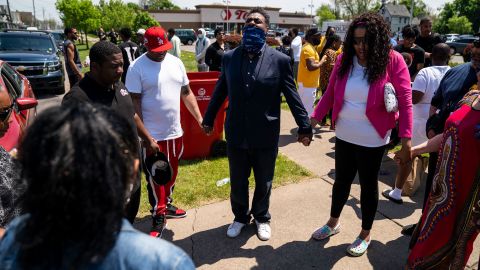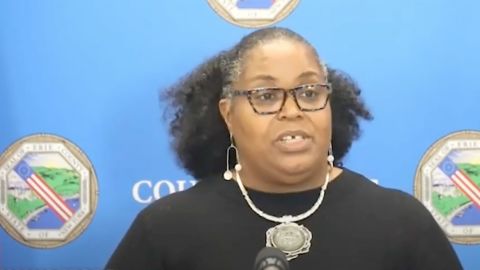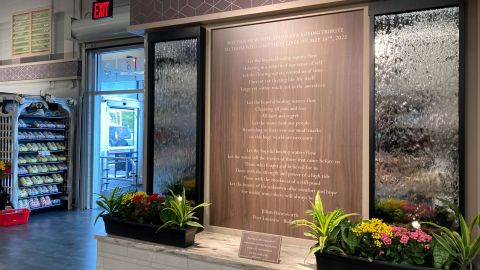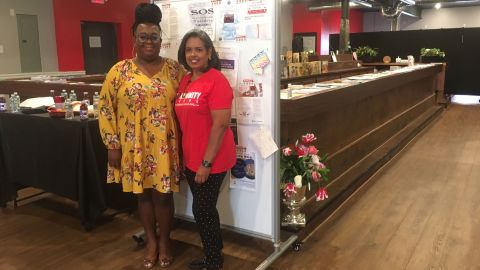[ad_1]
Buffalo, NY
CNN
—
The day after Buffalo suffered the worst mass shooting in its history, teams of emergency volunteers and mental health counselors arrived, offering emotional support and distributing food.
The response was strong and fast, but there was one big problem.
“The community was not comfortable coming up the stairs to the center because what they saw was a large group of white people,” said Kelly Wofford, director of health equity for Erie County.
On a busy Saturday in May, a white gunman deliberately opened fire at a Topps supermarket, the only grocery store in a predominantly black neighborhood. 11 of the 13 people, including the 10 killed, are black. Authorities described the shooting as racially motivated.
“In any other disaster, like a hurricane or flood, anyone offering resources would be happily welcomed, but this was different. “This tragedy had a face and a hatred for a certain group of people,” Thomas Beauford Jr. said. President and CEO of the Buffalo Urban League, one of the community organizations on site the day of the shooting.
“They completely rejected it,” Beauford said, “and the immediate response to counselors was, ‘We need to see counselors who look like us.'”

The problem was resolved by Monday. Wofford, who grew up down the street from Topps, tapped her network to ensure the site had more black counselors, who are black themselves. Handing out flyers On the street about available services and black people greeting people at the help desk.
“We made sure the affected community felt comfortable seeking the services they needed,” Wofford said.
Her response efforts — focusing on the ongoing inequities of the May 14 shooting — exemplify the role Erie County’s newly created Office of Health Equity is intended to play in the community: ensuring health services They are equally distributed among vulnerable and marginalized populations.
In Erie County, there is a significant disparity between the health outcomes of white residents and residents of color, made even more apparent as Covid-19 disproportionately affected black and brown communities there and across the country.
Even before the pandemic, the life expectancy of black Buffalo residents was 12 years shorter than that of whites, according to a report published by the Buffalo Center for Health Equity in 2015, the most recent data available. available
Erie County’s Office of Health Equity was launched to help address those disparities. It was established by county law in January and was made possible by a major federal pandemic relief package known as the American Rescue Plan, which distributed money to states, counties and cities across the country.

Erie County allocated nearly $1 million of the $179 million received from the American Rescue Plan to create the Office of Health Equity. It uses the remaining funds for a variety of purposes, including financial assistance for small businesses, water treatment infrastructure, and restoring jobs and expenses that were initially cut due to the pandemic.
Although issues of health equity were being addressed before the office was created, the law formalized the efforts and put funding behind them, ensuring it would work toward long-term solutions. Along with Wofford, the office has nine staff members, including two epidemiologists.
“The Office of Health Equity — which did not exist without the funding we received from the American Rescue Plan — immediately became an integral partner in the response to the Topps shooting on May 14. “The county delivers these services to the community on the ground and as a coordinator between third-party agencies,” said Erie County Executive Mark Poloncarz.
“It was unlike any experience we’ve ever had,” Poloncarz added, adding, “I’m so thankful we had the Office of Health Equity because without it, our job would have been much harder.”
Addressing health disparities is something communities across the country are struggling with, and when the pandemic caused illness and death for millions, it helped gather some momentum.
State and local health equity offices are not as widespread as water departments, for example. But they’re having a moment — thanks in part to an influx of money from the federal government to help communities recover.
“The pandemic has really highlighted the overall disparities in our ability to keep people healthy by race and ethnicity,” said Lori Tremmel Freeman, CEO of the National Association of County and City Health Officers.
The group hasn’t tracked how many formal equity offices it has opened, but the number is growing, Freeman said Said. Philadelphia hired its first chief racial equity officer earlier this year.
In the past, some communities lacked the political will or resources to formalize their health equity efforts, she added.

Police killings of black people, particularly the killing of George Floyd in Minneapolis, have prompted many communities to declare racism a public health crisis, laying the groundwork for some of the offices opening now. In April 2021, the US Centers for Disease Control and Prevention also declared racism a serious public health threat.
Addressing health disparities will take time and must address the social determinants of health. These are the factors that contribute to one’s health, such as clean water, healthy food, and other conditions that affect their health, such as work and play.
“You’re really trying to create the same opportunity for health for every person in the community, regardless of their economic status, where they live, whether they have a job,” Freeman said. Said.
In mid-July, the Topps grocery store reopened to mixed reactions from the community.
Without the supermarket, those without cars would have no access to nutritious food. For others, re-entering the store was emotionally difficult.
Migdalia Lozada, a crisis counselor with the Buffalo Urban League, offered support to shoppers one morning in August. Walking into the store for the first time since the tragedy, Lozada held a woman’s hand and felt the woman’s tears fall into his hand.
The Buffalo Urban League’s Community Resource Center, just two blocks from Topps, continues to serve the traumatized neighborhood. People can walk right into the space and talk to a crisis counselor. Some people are regulars who come almost every day. Others may have been triggered by an event such as a shooting or movement elsewhere Court case against accused who was shot.
“We try to give the person some space to open up in a safe and confidential space,” Lozada said.
While the Buffalo Urban League’s crisis counselors have been serving the community for months, its leaders wanted a physical space near the Topps store after the shooting. The team found an open space on the street that used to be a neighborhood bar known as Pixie’s and opened a resource center there. Within days of the disaster. The building intentionally looks more like a local water reservoir than a health facility.

The center also serves as a place to connect people with other resources to address various social determinants of health, such as employment, housing, and education.
The Buffalo Urban League plans to work with the county, particularly the new Office of Health Equity, to help advance long-term changes.
County The office is working first to train people in the Mental Health First Aid national program so the county can deploy counselors throughout the community — like at Bible studies and community centers — to meet people where they already are. Although the share of US adults seeking mental health treatment has increased throughout the Covid-19 pandemic, a recent nationwide study found that people of color are less likely to access mental health services.
The office is also working on a survey that partly shows what issues community members want addressed — it could be a higher prevalence of diabetes or high blood pressure, For example.
“When you look at the social determinants of health, there are disparities in all of them, so you can pick and choose what you want,” Wofford said.
[ad_2]
Source link
